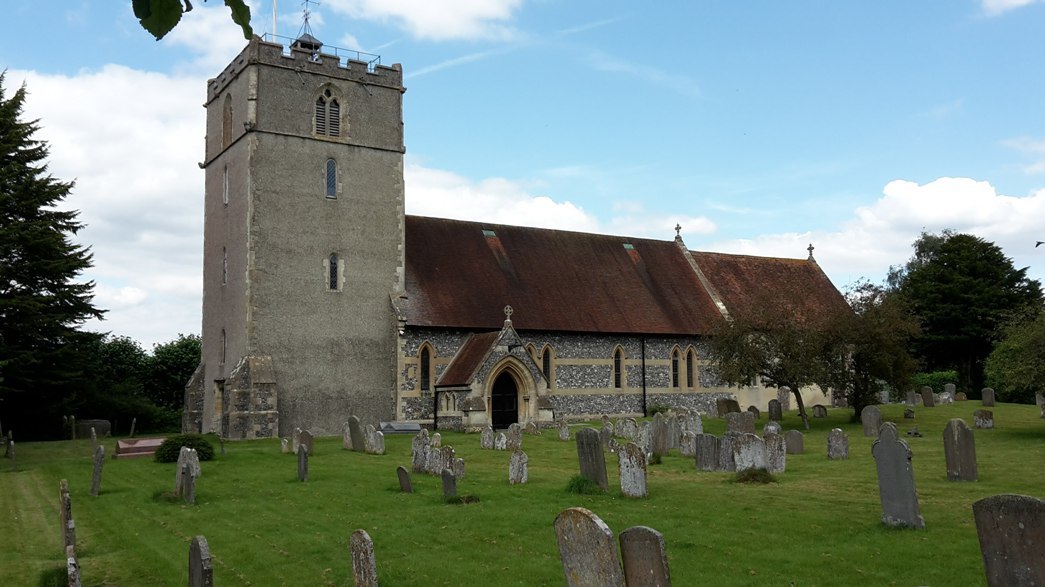This cache was set for the Chieveley Christmas Caper event, held on Saturday, 30 November 2019.
St Mary the Virgin church in Chieveley is the subject of Longpod's Church Micro 12797 cache, GC8A8W7. This cache invites you to study the materials used for the construction of the walls of the building in the area around the lancet windows on its south side.

FLINT
Flint is a commonly used building material across the Chilterns and into Wessex, due to its ready availability and durability. Flint is a microcrystalline rock made of silica and is considered to have begun forming soon after the deposition of chalk during the Cretaceous period from 65 to 145 million years ago. The silica replaced the original calcium carbonate (i.e. chalk), grain by grain, by a process of dissolving the carbonate and precipitating silica in its place. As chalk is an alkaline rock, an acid had to be present to dissolve the calcium carbonate so that the silica could form. The exact process by which this occurs remains the subject of debate but certainly involves bacterial activity in the sediment within the seabed, generating hydrogen sulphide. Where hydrogen sulphide meets dissolved oxygen from the surface of the sea, acidic conditions are produced, carbonate is dissolved and silica precipitated to form flint within the chalk matrix.
The silica that formed the flint derives from silica fixed in the skeletal structure of the myriad of marine organisms that lived in the sea at that time. The outside of flint nodules is normally white and their shape takes many forms, although they most commonly occur as random, separate nodules up to 2 feet (60 cm) across, with a knobbly appearance and are sometimes even perforated.
GRANITE
Granite is widely used as a building material due to its hardness and durable quality. It is resistant to many forms of erosion and presents a pleasing shine and smoothness when polished. Granite is a common type of felsic intrusive igneous rock that is granular and phaneritic in texture (i.e. the crystals are large enough to be visible). It can be found in many different colours from white to black via brown and pink. In composition, granite is made up primarily of quartz and feldspar minerals, with smaller quantities of dark mica and amphibole. These are normally present and visible as distinct crystals of varying size and colour. When one type of crystal is visibly larger than the others, these are termed 'phenocrysts' and can reach several inches in length.
Granite is used in buildings, bridges, paving, monuments, and many other exterior projects. Indoors, polished granite slabs and tiles are used in countertops, tile floors, stair treads and many other design elements.
SANDSTONE
Sandstone is a sedimentary rock composed of sand-size mineral particles or rock fragments. It also contains a cementing material that binds the sand grains together and may contain a matrix of silt- or clay-size particles that occupy the spaces between the grains of sand. Most sandstone is composed of quartz or feldspar because they are the most resistant minerals to weathering processes. Colours vary from dark red to very pale brown, with pink and even white varieties being found.
Sandstone has been a popular building material from ancient times. It is relatively soft, making it easy to carve. It has been widely used around the world in constructing temples, homes, and other buildings. It has also been used for artistic purposes to create ornamental fountains and statues.
EARTHCACHE QUESTIONS
In order to log this cache, please send me (either via email or the Geocaching.com message service) the answers to the following questions:
1) examine the southern side of the church building and describe the materials that have been used for its construction (grain or crystal size, texture, colour).
2) the darker material has a distinctive form. Describe the shape and size of the pieces of material.
3) from your observations, what are the materials you have described?
4) facing the south wall, turn your attention to the right-hand end of the wall. Near the ground is a carved memorial to a former vicar, J.E. Robinson. Just above and to the left of this stone is another carved stone. What was the purpose of this second stone and from what material is it made?
5) (OPTIONAL) a picture of you or your GPS with the church in the background is always welcome but please do not reveal the answer to any of the above questions in your photograph.
Note: permission to set this EarthCache has been granted by the East Downland Benefice. Visitors are kindly requested to respect the gravestones in the Churchyard and any service that may be in progress during your visit.
*** Well done to Wandering Druid and yellowwelly for a swift FTF ***